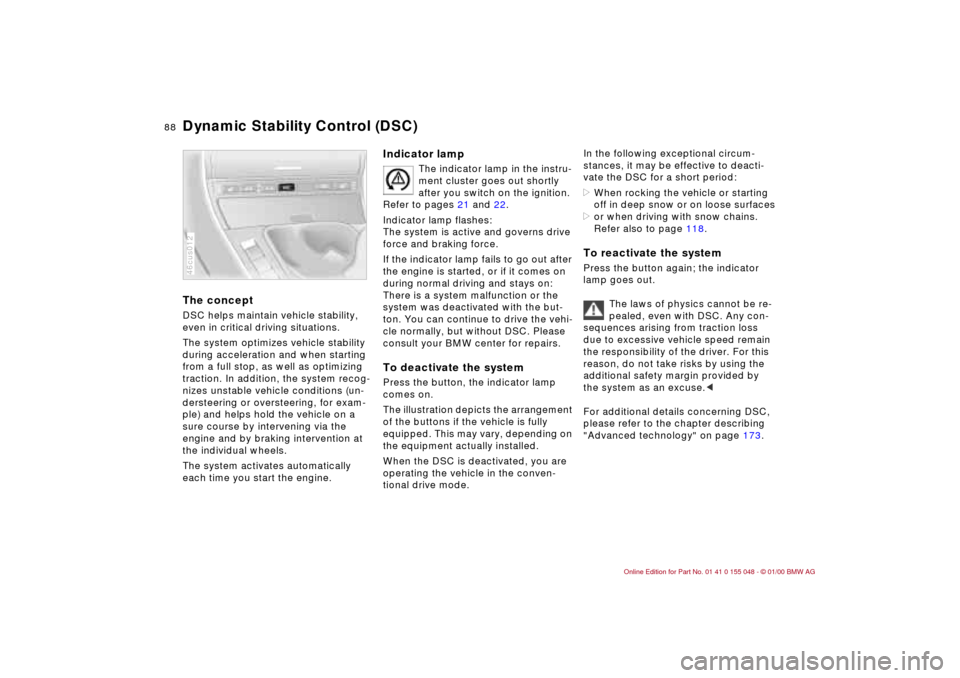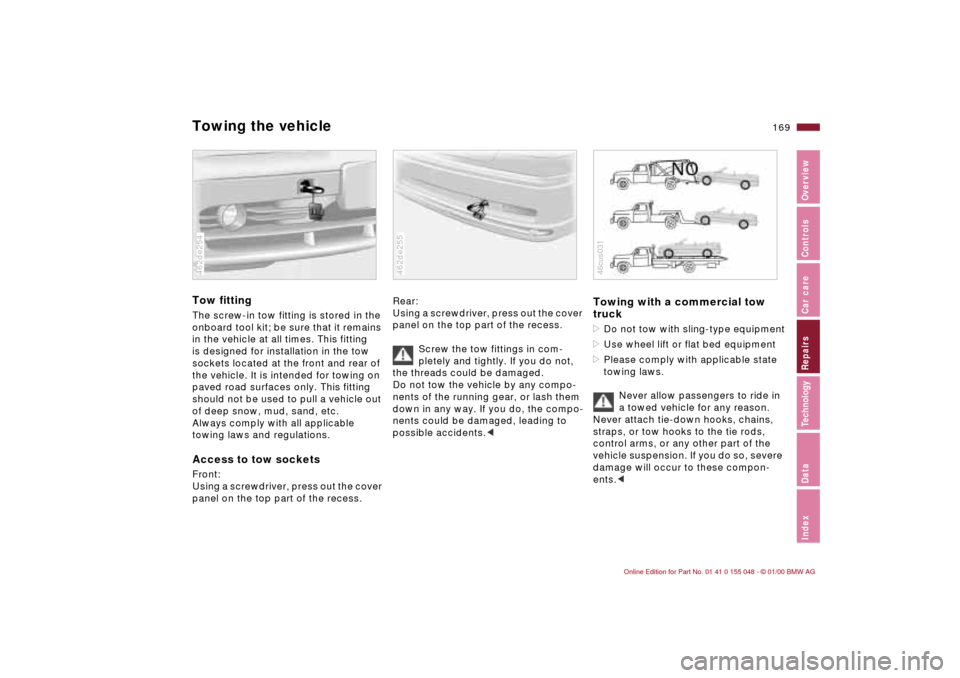2000 BMW 328Ci CONVERTIBLE snow chains
[x] Cancel search: snow chainsPage 11 of 199

11n
Controls and features
Operation, care and maintenance
Lamps:
Parking lamps/Low beams91
Instrument lighting91
High beams/Parking lamps92
Fog lamps92
Interior lamps92
Reading lamps93
Controlling the climate for
pleasant driving:
Automatic climate control94
Seat heating99
Cabin convenience:
Glove compartment99
BMW Universal
Transmitter *100
Storage compartments102
Cellular phone103
Ashtray front103
Cigarette lighter104
Ashtray rear104
Loading and transporting:
Ski bag105
Cargo loading106
Luggage rack for the
hardtop108
Special operating instructions:
Break-in procedures112
Driving notes113
Catalytic converter113
Antilock Brake System
(ABS)114
Disc brakes116
Brake system117
Winter operation118
Power steering120
Cellular phone120
Radio reception120
Hardtop121
Wheels and tires:
Tire inflation pressure123
Tire condition123
Tire replacement124
Tire rotation125
Wheel and tire
combinations126
Winter tires127
Snow chains127
Approved wheel and tire
specifications128
Under the hood:
Hood129
Engine compartment130
Washer fluids132
Washer nozzles132
Engine oil133
Coolant135
Brake fluid136
Vehicle Identification
Number137
Care and maintenance:
The BMW Maintenance
System138
Caring for your vehicle139
Cleaning and caring for your
convertible top144
Airbags146
Vehicle storage147
Laws and regulations:
Technical modifications to the
vehicle148
OBD interface socket149
Page 88 of 199

88n
Dynamic Stability Control (DSC) The conceptDSC helps maintain vehicle stability,
even in critical driving situations.
The system optimizes vehicle stability
during acceleration and when starting
from a full stop, as well as optimizing
traction. In addition, the system recog-
nizes unstable vehicle conditions (un-
dersteering or oversteering, for exam-
ple) and helps hold the vehicle on a
sure course by intervening via the
engine and by braking intervention at
the individual wheels.
The system activates automatically
each time you start the engine.46cus012
Indicator lamp
The indicator lamp in the instru-
ment cluster goes out shortly
after you switch on the ignition.
Refer to pages 21 and 22.
Indicator lamp flashes:
The system is active and governs drive
force and braking force.
If the indicator lamp fails to go out after
the engine is started, or if it comes on
during normal driving and stays on:
There is a system malfunction or the
system was deactivated with the but-
ton. You can continue to drive the vehi-
cle normally, but without DSC. Please
consult your BMW center for repairs.
To deactivate the systemPress the button, the indicator lamp
comes on.
The illustration depicts the arrangement
of the buttons if the vehicle is fully
equipped. This may vary, depending on
the equipment actually installed.
When the DSC is deactivated, you are
operating the vehicle in the conven-
tional drive mode.
In the following exceptional circum-
stances, it may be effective to deacti-
vate the DSC for a short period:
>When rocking the vehicle or starting
off in deep snow or on loose surfaces
>or when driving with snow chains.
Refer also to page 118.To reactivate the systemPress the button again; the indicator
lamp goes out.
The laws of physics cannot be re-
pealed, even with DSC. Any con-
sequences arising from traction loss
due to excessive vehicle speed remain
the responsibility of the driver. For this
reason, do not take risks by using the
additional safety margin provided by
the system as an excuse.<
For additional details concerning DSC,
please refer to the chapter describing
"Advanced technology" on page 173.
Page 111 of 199

Overview
Controls and features
Operation, care
and maintenance
Owner service procedures
Technical data
Index Advanced technology
111n
IndexDataTechnologyRepairsCar careControlsOverview
Special operating instructions:
Break-in procedures112
Driving notes113
Catalytic converter113
Antilock Brake System
(ABS)114
Disc brakes116
Brake system117
Winter operation118
Power steering120
Cellular phone120
Radio reception120
Hardtop121
Wheels and tires:
Tire inflation pressure123
Tire condition123
Tire replacement124
Tire rotation125
Wheel and tire
combinations126
Winter tires127
Snow chains127
Approved wheel and tire
specifications128Under the hood:
Hood129
Engine compartment130
Washer fluids132
Washer nozzles132
Engine oil133
Coolant135
Brake fluid136
Vehicle Identification
Number137
Care and maintenance:
The BMW Maintenance
System138
Caring for your vehicle139
Cleaning and caring for your
convertible top144
Airbags146
Vehicle storage147
Laws and regulations:
Technical modifications to the
vehicle148
OBD interface socket149
Car care
Page 114 of 199

114n
Antilock Brake System (ABS)The concept ABS enhances active driving safety
by helping to prevent the wheels from
locking while braking. This is because
locked wheels are dangerous. When
the front wheels slide, the driver loses
steering control over the vehicle.
Traction loss at the rear wheels can
cause the rear end to break into an
uncontrolled skid.
ABS is designed to meet two essential
requirements during every brake appli-
cation:
>To help provide vehicle stability
>To help maintain steering control and
maneuverability – on all types of road
surfaces (asphalt, concrete, mud, wet
road surfaces, snow, ice).
The system can achieve the shortest
braking distances possible under most
conditions (on straight aways and in
curves, on asphalt, ice, wet road sur-
faces, etc.).
Braking with ABSThe system is operative once the vehi-
cle exceeds a speed of approx. 6 mph
(10 km/h). It is deactivated once again
below approx. 4 mph (6 km/h). This
means that the wheels can lock in the
final phase of a panic stop – a factor of
no significance in actual use.
If you are in a situation that requires full
braking, you will exploit the full benefits
of the ABS system if you apply maxi-
mum brake pressure ("panic stop").
Since the vehicle maintains steering
responsiveness, you can nevertheless
avoid possible obstacles with a mini-
mum of steering effort.
The ABS closed-loop control circuit
cycles in fractions of a second. A pulsa-
tion at the brake pedal, together with
the sounds associated with the hydrau-
lic controls, tells you that the brake sys-
tem is within its maximum limit range,
and reminds you that you should adapt
road speed to the road conditions.
On road surfaces that have a loose
surface layer on a firm base with good
traction (on gravel or snow, for exam-
ple), or when snow chains are mounted,
braking distances may be longer than
with locked wheels. However, ABS continues to provide
enhanced vehicle stability and steering
response under these conditions.
Information for your safetyNot even ABS can suspend the laws of
physics. ABS cannot prevent the conse-
quences of brake applications with inad-
equate clearances for safety between
vehicles, when exceeding the speed
limit in curves, or the risks involved
when aquaplaning occurs. Responsibil-
ity for these types of situations remains
in the hands (and at the feet) of the
driver. You should never allow the
added safety of ABS to lull you into a
false sense of security, or mislead you
into taking increased risks that could
affect your own safety and that of others.
Do not make any modifications to
the ABS system.
Service procedures on ABS are to be
performed by authorized technicians
only.<
Page 118 of 199

118n
Winter operationWinter is often accompanied by rapid
changes in weather, requiring not only
a different driving style, but also certain
preparations to the vehicle itself to en-
sure that your vehicle operates safely
and trouble free throughout the winter
months.CoolantBe sure that the coolant mixture con-
tains the year-round ratio of 50:50
water and antifreeze/corrosion protec-
tion. This mixture provides protection
against freezing down to approx. –34 7
(–37 6). Replace the coolant every four
years.LocksBMW door lock deicer can be used to
free them if frozen. This deicer also
contains lubricant.
After its use, treatment with BMW lock
barrel grease is recommended.
Rubber seals and components To prevent the weather stripping from
freezing, apply a spray-on rubber treat-
ment or silicone spray to the door, hood
and luggage compartment lid seals.
A full range of car care products is
available from your BMW center.
them in pairs on the rear wheels only
and comply with the manufacturer's
safety precautions. Do not exceed a
maximum speed of 30 mph (50 km/h).
In this type of exceptional situation
where the snow chains are mounted,
deactivate the DSC. Refer to page 88.
Starting offWhen starting off from a full stop in
deep snow or when "rocking" the vehi-
cle to free it, it may be effective to
deactivate the DSC system for a short
period. Refer to page 88.Driving on low-traction road
surfacesUse smooth, gentle pressure to control
the accelerator pedal. Avoid excessive
engine speeds and shift to the next
higher gear at an early point. On down-
hill grades or slopes, shift down to the
next lower gear at an early point. Main-
tain an adequate distance between
yourself and the vehicle ahead.
Page 127 of 199

127n
IndexDataTechnologyRepairsCar careControlsOverview
Do not exceed specified
maximum speeds
Never exceed the maximum speed
for which winter tires are rated.
Unprofessional attempts by laymen to
service tires can lead to damage and
accidents.
Have this work performed by skilled
professionals only. Any BMW center
has the required technical knowledge
and the proper equipment and will be
happy to assist you.<
Tire condition, tire pressureOnce the tire wears to a tread depth
below 0.16 in (4 mm), winter tires dis-
play a perceptible decrease in their
ability to cope with winter driving condi-
tions, and should be replaced in the
interest of safety.
Comply with the specified tire inflation
pressures – and be sure to have the
wheel and tire assemblies balanced
every time you change the tires.
Winter tiresChoosing the right tireBMW recommends winter tires (M+S
radial tires) for driving in adverse winter
road conditions. Although all-season
tires with the M+S identification provide
better winter traction than summer tires
with H, V, W Y and ZR speed ratings,
they generally fail to provide the same
levels of performance as standard
winter tires.
In the interests of safe tracking and
steering response, install winter tires
made by the same manufacturer having
the same tread configuration on all four
wheels.
Mount only winter tires which have
been approved by BMW. Any BMW
center will be glad to provide you with
information on the best winter tires for
your particular driving conditions.
StorageAlways store tires in a cool, dry place.
Store them away from light whenever
possible. Protect the tires against con-
tact with oil, grease and fuel.Snow chains
*
The use of narrow-link BMW snow
chains on summer or winter tires is
approved only in pairs and only on the
rear wheels. Comply with all manufac-
turer's safety precautions when mount-
ing the chains.
Page 128 of 199

128n
Approved wheel and tire specifications Tire specifications Steel rim
(wheel rim)Light-alloy
wheel
Summer tires
205/55 R 16 91 H
225/50 R 16 92 W
225/50 ZR 16 –
–
–7Jx16
7Jx16
7Jx16
205/50 R 17 93 W extra load – 7Jx17
225/45 R 17 91 W – 8Jx17
Front: 225/40 ZR 18 – 8Jx18
Rear: 255/35 ZR 18 – 8.5Jx18
Winter tires (M+S)
205/55 R 16 91 Q/T/H
225/50 R 16 92 Q/T/H–
7Jx167Jx16
7Jx16
205/50 R 17 93 Q/T/H extra load – 7Jx17
225/45 R 17 91 Q/T/H – 8Jx17
Space-saver spare tire
T 115/90 R 16 92 M 3.0Bx16 –
T 125/90 R 16 98 M 3.5Bx16 –
T 125/80 R 17 99 M 3.5Bx17 –
Comply with the specifications for tires and wheels in the
vehicle's documents.
If you install tire sizes not approved by the manufacturer, you
may have to enter this information in the vehicle documents.
Only light-alloy wheels are to be used
for summer tires.Snow chains
*
You cannot mount snow chains on the
following tires:
225/50 R 16 92 W
225/50 ZR 16
225/40 ZR 18
255/35 ZR 18
225/45 R 17 91 W
225/50 R 16 92 Q/T/H
225/45 R 17 91 Q/T/HMixed tiresFor details concerning tire manufactur-
ers for mixed tires, refer to the specifi-
cations in the vehicle documents.
Page 169 of 199

169n
IndexDataTechnologyRepairsCar careControlsOverview
Towing the vehicleTow fittingThe screw-in tow fitting is stored in the
onboard tool kit; be sure that it remains
in the vehicle at all times. This fitting
is designed for installation in the tow
sockets located at the front and rear of
the vehicle. It is intended for towing on
paved road surfaces only. This fitting
should not be used to pull a vehicle out
of deep snow, mud, sand, etc.
Always comply with all applicable
towing laws and regulations.Access to tow socketsFront:
Using a screwdriver, press out the cover
panel on the top part of the recess.462de254
Rear:
Using a screwdriver, press out the cover
panel on the top part of the recess.
Screw the tow fittings in com-
pletely and tightly. If you do not,
the threads could be damaged.
Do not tow the vehicle by any compo-
nents of the running gear, or lash them
down in any way. If you do, the compo-
nents could be damaged, leading to
possible accidents.<462de255
Towing with a commercial tow
truck>Do not tow with sling-type equipment
>Use wheel lift or flat bed equipment
>Please comply with applicable state
towing laws.
Never allow passengers to ride in
a towed vehicle for any reason.
Never attach tie-down hooks, chains,
straps, or tow hooks to the tie rods,
control arms, or any other part of the
vehicle suspension. If you do so, severe
damage will occur to these compon-
ents.c46cus031